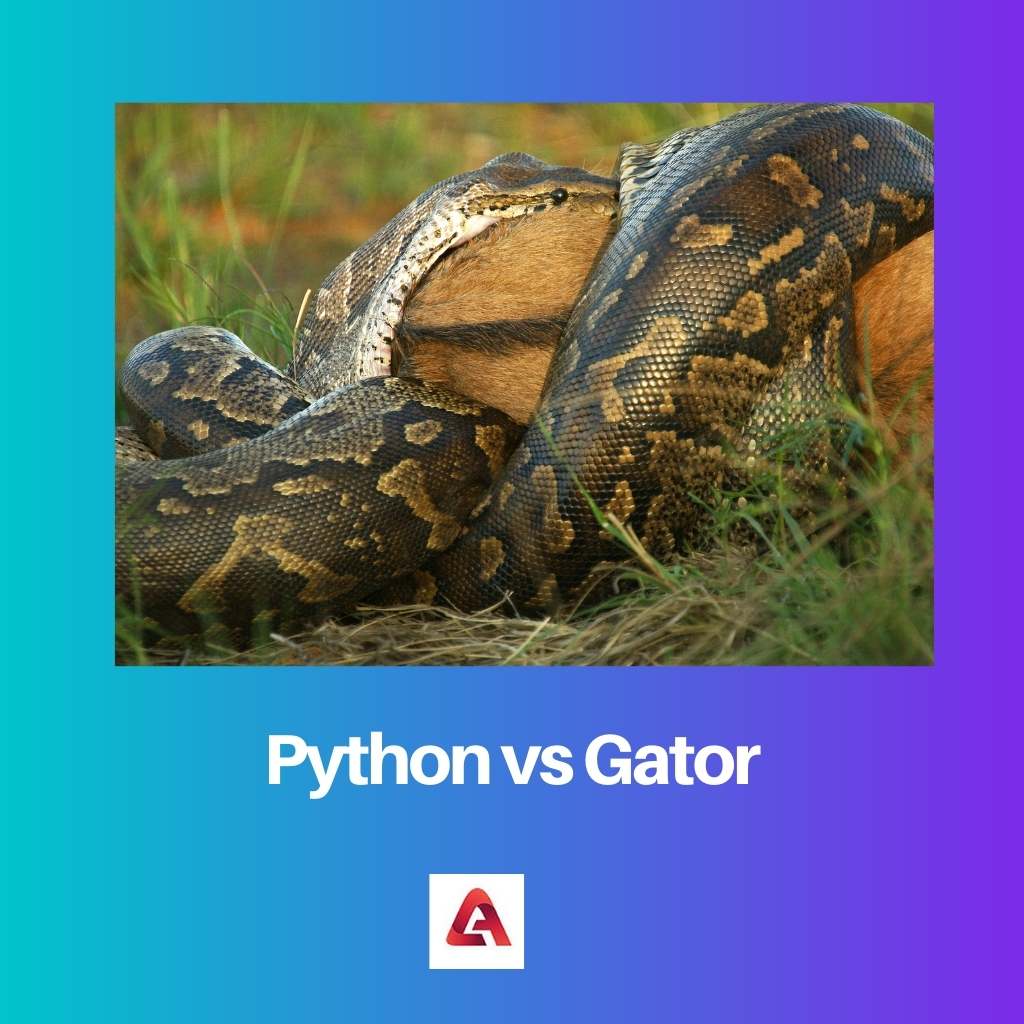Pythons and gators can be distinguished easily by their appearance.
They look nothing alike, the first is a snake, and the second belongs to the species of alligator. What they share in common is that both are affiliated with the reptile family.
They share the same family, and they share differences as well.
Key Takeaways
- Pythons are nonvenomous constrictor snakes, while gators are short for alligators, which are large reptiles.
- Pythons kill their prey by constriction, while alligators use their powerful jaws to catch and crush prey.
- Alligators are found primarily in freshwater habitats, whereas pythons can be found in various environments.
Python vs Gator
The difference between pythons and gators is that pythons are snakes, and gators are alligators that live in China and the southern US. Pythons are found in Asia and Africa. Pythons are not venomous, but they are dangerous, just like gators. Gators have a strong bodies, but pythons do not possess such an impenetrable body.

Pythons are long snakes that squeeze their prey to death. This is the only weapon they have, as they are not poisonous. They can be found in tropical places, such as Asia, Australia and Africa. Their pit below the jaw can detect warm prey for them to eat.
Gators, a reptile, is a type of crocodile. Gator is a short-term alligator. Like crocodiles, they have hard skin. A tropical environment is best suited for gators.
These animals grow in freshwater. They can be found in rivers, ponds, swamps and other water. They keep their eggs on the mound of leaves.
Comparison Table
| Parameters of Comparison | Python | Gator |
|---|---|---|
| Overview | Pythons are snakes that are not venomous. | Gator is a reptile that belongs to the genus of Alligator. |
| Hatch of eggs | Pythons coil around their eggs in order to make them warm. | Gators lay eggs on a stack of leaves to keep the eggs warm. |
| Habitat | Asia, Australia and Africa are native places of pythons. | Southern US and China are natural habitats of gators. |
| Body | It has a long body with a large head and is thin. | They possess an extremely hard body due to bony plates under the skin. |
| Family to belong | Pythons belong to the Pythonidae family. | Gators belong to the Alligatoridae family. |
What is Python?
Pythons come from the family of Pythonidae. These snakes are not poisonous. As having no ears, their only source of hearing is sensing the surrounding movements.
Being reptiles, they can feel the vibration through the ground, and thus they follow their prey.
Pythons can grow over 30 feet, but some small ones can also be seen. Their lower jaws have heat-sensing pits which help them to search for warm-blooded targets. Being non-poisonous, their weapon is to squeeze their victims till they die.
Pythons live in the Saharan of Africa and India. The Australian pythons do not grow much. Pythons do not function as live-bearers. Instead, they lay eggs.
Female pythons coil around their laid eggs to pass the temperature and keep them warm. This process is called incubation.
The python’s skin gets used in making clothes and other fashion accessories such as belts, shoes, and handbags. It also gets used as strings in the making of musical instruments.

What is Gator?
Alligators are widely known as gators. They are reptiles and, therefore, cold-blooded. They are born predators, and they share the same family as crocodiles.
Only the gator is native to the southern US and China. They are large, and their skin is so strong that it is impenetrable.
This aquatic animal can not give the eggs the warmth it needs till they hatch. So they lay eggs on the pile of leaves, the leaves gradually rot, and it creates the necessary heat for the eggs to hatch.
The baby gators have a tooth that helps them to cut the shells to come out in the world.
A gator eats many things. When they are young, they feed themselves on fish, worms and insects, but as they grow older, they start to take big prey such as birds, deer, turtles, big fish and many other mammals.
Even though they are a lot like crocodiles, they do not take humans as prey, but they might attack humans in the act of self-defence.

Main Differences Between Python and Gator
- Pythons belong to the family of snakes; however, it is not venomous, and the gator comes from the family of Alligators.
- Pythons have long body without having backbones. That is, they are invertebrates. Conversely, Gators have a very strong body caused by the bony plates below their skin. As a result, the gator’s skin is impenetrable, but the python’s skin is not.
- Pythons come from the family of the Pythonidae family. On the other hand, gators come from the family of Alligatoridae.
- Pythons and gators have different methods of Incubation. A python coil around its eggs to keep them warm for hatching, whereas a gator lays eggs on the pile of leaves so they can get warm till the point of hatching.
- Pythons are habitants of mainly Asia, Africa and Australia. However, gators can be found mostly in China and the southern US.




